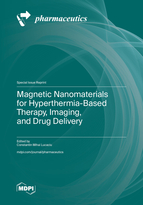Magnetic Nanomaterials for Hyperthermia-Based Therapy, Imaging, and Drug Delivery
A special issue of Pharmaceutics (ISSN 1999-4923). This special issue belongs to the section "Nanomedicine and Nanotechnology".
Deadline for manuscript submissions: closed (30 September 2023) | Viewed by 21805
Special Issue Editor
Interests: magnetic nanoparticles; magnetic hyperthermia; plasmonic nanoparticles; vibrational spectroscopy; Surface Enhanced Raman Spectroscopy (SERS); liposomes
Special Issues, Collections and Topics in MDPI journals
Special Issue Information
Dear Colleagues,
In recent decades, we have witnessed tremendous developments in the field of nanomedicine. Among other nanoformulations, magnetic nanoparticles have been proven to possess numerous benefits over conventional medicines, making them valuable candidates in various fields of biomedical applications due to their ability to be remotely controlled by external magnetic fields.
By either functionalizing their surface or creating hybrid nanoformulations in combination with polymers, fluorophores, liposomes, and plasmonic or silica shells, magnetic nanoparticles gain multiplexing capabilities, making them suitable for combined applications, leading to what we now call theranostic nanoparticles. The capacity of these magnetic nanomaterials to diagnose and treat medical conditions, combined with the possibilities of remotely controlling their position or triggering their activity, make them one of the most investigated classes of theranostic materials.
In this Special Issue, we kindly invite authors to report both experimental and theoretical results on their recently developed magnetic nanomaterials in the medical field for imaging, diagnostics, and the treatment of diseases.
Prof. Dr. Constantin Mihai Lucaciu
Guest Editor
Manuscript Submission Information
Manuscripts should be submitted online at www.mdpi.com by registering and logging in to this website. Once you are registered, click here to go to the submission form. Manuscripts can be submitted until the deadline. All submissions that pass pre-check are peer-reviewed. Accepted papers will be published continuously in the journal (as soon as accepted) and will be listed together on the special issue website. Research articles, review articles as well as short communications are invited. For planned papers, a title and short abstract (about 100 words) can be sent to the Editorial Office for announcement on this website.
Submitted manuscripts should not have been published previously, nor be under consideration for publication elsewhere (except conference proceedings papers). All manuscripts are thoroughly refereed through a single-blind peer-review process. A guide for authors and other relevant information for submission of manuscripts is available on the Instructions for Authors page. Pharmaceutics is an international peer-reviewed open access monthly journal published by MDPI.
Please visit the Instructions for Authors page before submitting a manuscript. The Article Processing Charge (APC) for publication in this open access journal is 2900 CHF (Swiss Francs). Submitted papers should be well formatted and use good English. Authors may use MDPI's English editing service prior to publication or during author revisions.
Keywords
- magnetic hyperthermia
- magnetoplasmonic nanoparticles
- targeted drug delivery
- magnetoliposomes
- magnetic resonance imaging
- magnetic particle imaging
- magnetorelaxometry imaging







